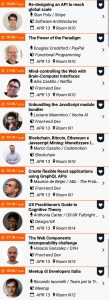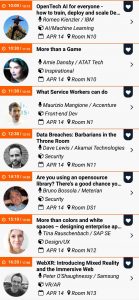The codemotion is back on the scene like every year, this time in Rome for the month of April, and to keep bench rather than new and flaming JavaScript frameworks (😅) are more and more news from the W3C built-in-the-browser that come adopted at an ever-increasing speed by our dear browser makers.
https://rome2018.codemotionworld.com/
Part 1 – Friday, April 13th
The Power of the Paradigm
The web as it was originally conceived, it should have been a network of links between hypertextual documents, but the commercial and dynamic developments have increasingly highlighted the need for new and safer protocols to manage the new centrality of the Internet in our lives. Numerous open source players are therefore reinventing the ways to authenticate, communicate in a secure but fast way between two interlocutors on the network and much more.
Mind-controlling the Web with Brain-Computer Interfaces
All you need to interact with a computer is an input interface for which the machine can recognize and interpret its signals. We are used to mouse and keyboard and joypad of various types that use our hands, but are also starting to be marketed devices that can measure the electrical activity of our brain and translate it into impulses that can be used at the software level. Certainly the degree of current approximation is really high but sufficient to create interesting experiments.
Unbundling the JavaScript module bundler
Web applications are getting bigger and more complex, and to manage this complexity the best approach is to have small reusable modules to be combined like Lego ™. However, we are still largely bound by the HTTP 1.1 protocol that requires us to concatenate together all the resources needed for a page in a single package to save valuable time in ping-pong connections between clients and servers, so knowing how to use a module bundler is important. This is usually one of those architectural aspects that in a single application is usually dealt with at the beginning of the project and rarely modified, however the best way to understand how a module bundler works and why it is useful is make one of your own hand.
Blockchain, Bitcoin, Ethereum and JavaScript Mining
The hype surrounding cryptocurrencies does not seem to fade, in particular the ability to exploit the CPU of a web visitor opens the door to potential new business models where the hateful but necessary advertisement could be, perhaps not replaced but at least reduced, thanks to JavaScript mining libraries.
Create flexible React applications using GraphQL APIs
If there is a technology that has been able to win the headlines among the developers that is certainly React and ReactJS, but it is not the only revolutionary technology released by Facebook.
GraphQL, perhaps less famous but not less important, represents a truly revolutionary approach to manage the interaction between client and server, overturning the REST paradigm where a client that contacts a server must know the endpoint responsible for providing specific information whose answer is more or less always the same, in the jargon of JSON contract terms.
With GraphQL instead the server becomes a flexible interlocutor, which is programmed to find various types of information, allows through a single entry point to request information also of different services, then combine the backend side of the answers, providing a JSON in the exact format required by the client , opening the doors to enormous potential in the field of MVT and management of different clients, such as web and native, avoiding the duplication of business logic.
UX Practitioner’s Guide to Cognitive Theory
Web pages are not all the same, we know that now, and it is also the reason why some ecommerce are more successful than many others, and wanting to summarize the decisive factor of their success in a single word this would be “simplicity”. Anthonia Carter shows us how cognitive theory comes to the rescue of UX designers, helping to identify what may represent an obstacle for the understanding of users for written texts, images and other elements that can compose a web interface.
The Web Components Interoperability challenge
While the backend world has been starting for some years to embrace the micro-services approach as a philosophy of small components that are orchestrated together to make up a more complex product, the frontend is slowly starting to approach the same degree of maturity by means of libraries such as ReactJS and Angular, that are strongly oriented to the so-called “components”, however, the browsers had not yet made available “native” tools to meet this need and each library interpreted this theme in its own way.
The W3C has not been inert, and the Web Components are starting to appear on various browsers bringing features of isolation and independence compared to the global scope of the page, and Horacio Gonzales illustrates how we can now use the Web Components through libraries like Polymer that they deal with the implementation differences currently existing between the various browsers, and to perform polyfilling on older browsers.
Meetup Developers Italia
The IT department of the so mistreated public administration is without a doubt the Achilles heel that generates inefficiency and bureaucracy in all Italian public services, but it does not necessarily have to be a curse to surrender to.
This is the reason Diego Piacentini, former Vice President of Amazon, has come back to Italy, specifically to lead the new Italian PA Digital Team pro bono, to restart the country’s “digital system”, based on the open source philosophy.
The Developers Italia Team then illustrates the GitHub codebase to which any willing developer can make his own contribution to lay the foundations of a better PA that can keep up with changing times.
Part 2 – Saturday, April 14th
OpenTech AI for everyone
Artificial intelligence is a subject that is becoming more and more an hot topic, not only in terms of interest for companies but also in the consequences for society, in terms of employment and social life. Romeo Kienzler shows us the giant steps that AI is making in the fields of semantic recognition of human natural language and optical recognition on images, showing that the boundary between what was believed to be science fiction and science is becoming increasingly smoky.
More than a Game
The video games developer Amie Dansby opens the day telling us how a multifaceted training, not focused on a single topic, bring unexpected benefits even in their technical work, both in terms of individual experiences cultivating interests of various natures, and joining people with different experiences in multidisciplinary teams.
Opportunities to learn are never lacking, the key is to always keep a flexible mind, open, and ready to be surprised by others.
What Service Workers can do
In the continuous striving of the web to fill the gap with the native app, Service Workers offer the potential to bypass the single threaded nature of JavaScript allowing to run services relevant to a web page that operate independently from the same page. Maurizio Mangione shows us the state of the art of this technology and which are the most virtuous browsers in this sense (spoiler, Safari is not on the list).
Data Breaches: Barbarians in the Throne Room
The gold of the new millennium is not found underground but in the various “clouds” generated in recent years to provide cloud functionality not only to users but also to companies, not just SMEs but also increasingly large companies. The management and maintenance of datacenter is an activity in itself extremely complex as it is fundamental to keep evolve online activities and more and more big players start to adopt the solutions proposed by big as Azure of Microsoft or AWS of Amazon to outsource and not having to take care of this expensive aspect of the business, but there may be unwelcome consequences if not carefully made.
Dave Lewis brings us a press review of the worst data breaches ever, which have earned the front pages of international newspapers, analyzing what were the root causes of these incidents, which in most cases range from the trivial forgetfulness to change default configurations to prevent anyone from breaking through an open door, to the simple negligence of not checking whether a cloud server with sensitive data is public or not.
Security and OpenSource libraries
It is very easy to go to the terminal and type npm install something , but do we ever wonder what are the potential risks to which we expose ourselves in doing so?
Open source software is a positive revolution, but not all programmers around you have good intentions, Bruno Bossola shows us how it is possible that a package seemingly harmless may contain malicious components, for example by tracing data without our knowledge, and which famous incidents have led the community to develop an awareness of this problem that will continue to accompany open source libraries in the years to come.
More than Colors and White Space – Designing Enterprise Application
Tina Rauschenbach illustrates the processes with which she has managed the graphic renewal of a widespread SAP enterprise application, and the kind of challenges that such a Business2Business activity poses compared to modifying an UI / UX designed for a Business2Consumer audience.
WebXR: Introducing mixed reality and the Immersive Web
Augmented reality is one of the fields that has always enjoyed particular attention in cinema as an icon of the future and science fiction, Samsung brings science fiction in the present with WebXR technology that allows the Samsung Browser (aka stock browser on the various Android devices of the company) to take advantage of three-dimensional contents superimposed on images taken by the camera.
That of augmented reality is still a very uneven field in the web environment, lacking a true standard shared between the various high-tech companies, however as individual companies move forward and define better the requirements, compromises will arrive.


